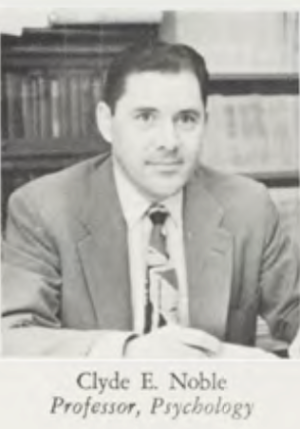Human Variation
 Human variation — that is, inequality — has always existed in fact, and science demonstrates it every single day.
Human variation — that is, inequality — has always existed in fact, and science demonstrates it every single day.
HUMAN VARIATION (Academic Press, N.Y.) is edited by R. Travis Osborne and Clyde E. Noble (pictured), psychologists of international repute based at the University of Georgia. Nathaniel Weyl is also named an editor, although all he contributed was a plodding two and a half page preface. In all, Human Variation offers ten major boosts to the nature side of the nature-nurture feud, plus an epilogue by Cyril D. Darlington, Oxford geneticist and author of the memorable Evolution of Man and Society.
The first chapter is the work of Dwight J. Ingle, Professor Emeritus of Psychology, University of Chicago, who neatly vivisects the living, livid fallacies that are the stock in trade of liberals whose habit it is to cover up human and racial differences with smears, silence or confusion. If the reader wishes to learn how to refute, deflate and shoot down the nonsensical claims of the equalitarians, he will find a whole arsenal of verbal ammunition in Ingle’s article. Montague Francis Ashley Montagu has written, “IQ tests do not provide any measure whatever of intelligence.” Ingle easily handles this kind of barefaced persiflage. Neither is he afraid to take on more sophisticated and subtle word games which rely heavily on such polemical dodges as simplism, petitio principii, secundum quid, ex cathedra pronouncements, arguments ad novitam and ad antiquitam, faulty criteria, negative instances, ostensive definitions and many more.
David C. Rife, Professor Emeritus of Zoology, Ohio State University, author of the second chapter, “Genes and the Melting Pot,” devotes several interesting pages to fingerprints. The prints of American Jews show a definite racial link to Middle Eastern non-Jews (a relationship which doesn’t lend much support to the Khazar theory). Australoids have the highest fingerprint indices (ratios of whorls, loops and arches) in the world, while American Indians have prints that are more similar to those of East Asian Mongoloids than to American blacks and whites. Palm prints, we learn, are also being used to identify people and peoples. Dr. Rife also takes a close look at pleiotropy, the effect of a particular gene on two or more traits, and reports on such little-known genetic diseases as phenylketonuria and favism, and such well-known ones as gout. Rife concludes with a fascinating rundown on the genetic bonds of hybrid races in the U.S.
As expected, the chapter by Arthur Jensen hews closely to the mathematical objectivity and rigorous scientific methodology which always distinguish his work. Jensen, as the title of his study, “Genetic and Behavioral Effects of Nonrandom Mating,” suggests, is investigating the effects of marital choosiness. His findings show that the human traits most important to European and North American whites in their choice of spouse are “age, amount of formal education and IQ.” This selective mating process “may account for over half of the frequency of persons with IQs above 130 and four out of five of those with IQs over 145, and there are approximately 20 times as many persons above an IQ of 160, as we would find if there were no assortative mating for intelligence.”
Jensen brings out the now well-established thesis that male intelligence has a much wider “spread” than female intelligence, which accounts not only for the greater number of male geniuses, but also for the excess of male morons. He adds, however, “the great cultures of the past are distinguished largely by the number of their creative geniuses, not by their rates of mental deficiency …As a factor in cultural evolution, the amount of variability of talents in a population could be more important than its overall mean … It has been estimated that in England some 20% of the variance in IQ is attributable to assortative mating.”
As for the bleak decline of intelligence in the U.S., Jensen has one bit of good news. “The average number of offspring born to all persons with IQs below 75 is less than for the general population mainly because most intellectually retarded persons never marry … A high degree of assortative mating for intelligence, which increases the IQ variance in the population, results in the birth of a larger proportion of persons who fall below the mating threshold, so that their genes for low intelligence are less likely to be passed on to the next generation, with the result that the population gene pool for intelligence is slightly improved. There is evidence that a eugenic effect of this nature has been taking place in the Caucasoid population of the United States …”
Esthetically, Jensen is a relativist. For him there are no absolute standards of beauty. He is not inspired by the ideal Nordic stereotype, which still dominates the female side of Hollywood and the model industry. He does, however, admit the attraction of beauty for brains, or as others might call it beauty (Nordic women) for the beast (Jewish millionaires). But it seems to escape him that the undeniable physical ugliness of so many of today’s money-men, though mating with a Nordic or other handsome White type may make their children more handsome than the Jewish mean, certainly lowers the White mean.
Much of Jensen’s essay is devoted to inbreeding. Since 99 percent of human history has taken place when primitive human hunting bands comprised not more than 200-300 persons of all ages (50-75 breeding pairs), our ancestors were necessarily endogamous. Only with the advent of organized farming some eight to ten millennia ago was there a noticeable rise in exogamic mating. Even today in some small population groups, numbering from 1,500 to 4,000 members, in Europe, North America and black Africa, there is 80 percent endogamy, with almost everyone at least the third cousin of everyone else. Inbreeding has the advantage of exposing and consequently eliminating deleterious genes. On the other hand, it acts as a lethal reservoir of harmful recessive genes. “Animal breeders,” Jensen writes, “strongly inbreed their line in order to rid them of undesirable characteristics, which are systematically culled, and then the lines are outcrossed again to counteract inbreeding depression.”
John L. Horn, Professor of Psychology, University of Denver, has entitled his contribution “Intellectual Ability.” It is his view that all special abilities, mental and physical, have some correlation with intelligence — i.e., a person with fast reflexes is also likely to have a fast mind. Horn differentiates between primary and secondary memory, the former storing up information for survival, the latter operating on the principle of association. The higher primates, for example, have a primary memory that can almost be compared to that of humans.
In reviewing how human intelligence develops from birth onward, Horn asserts that conditioning unfortunately works just as effectively on bright minds as dull. But bright minds improve with age and seem to be as important as healthy bodies in staving off Old Man Time. Of the 50 primary mental abilities that, Horn says, comprise intelligence, almost all have a solid genetic base.
The most newsworthy of all the chapters is R. T. Osborne’s “The Study of Negroid and Caucasoid Twins.” Although twin studies have always furnished the best evidence for the hereditary component of man, Osborne’s research has a special importance because it is the largest and most comprehensive racial study to date of black and white twins. In all, 304 sets of white and 123 sets of black twins, after having been carefully classified as identical (one-egg) or fraternal (two-egg) twins, were subjected to a battery of 12 psychological tests designed to measure their primary mental abilities — among them the Calendar Test, the Cube Comparison Test, mathematical and vocabulary tests, tests involving the folding of paper to make certain geometrical forms, etc. High heritability factors were found for both races in most tests, with the usual allowance for social class and environment entering into the final assessment. But some tests, in addition to revealing the standard hereditary influences at work on both blacks and whites, also showed profound mental differences between the races.
All serious social scientists agree that a 40-80% hereditary factor governs human intelligence for whites. Osborne’s study is the first conclusive proof that the same percentages apply equally to Negroes. With the inference valid for two races, hereditary estimates now have much greater credibility. Osborne’s great study, moreover, has an added significance. It was completed only a few months before HEW imposed severe restrictions on further use of human subjects in experiments involving psychological tests. Accordingly, it is not only the latest word in the heredity story but, at least for the foreseeable future, it may be the last word.
A most controversial chapter in this most controversial book is “Sex Linkage” by Richard G. Lehrke, Clinical Psychologist, Brainerd State Hospital, Minnesota. Lehrke wades right into his subject by stating that all female psychologists deny there are appreciable mental differences between the sexes, while nearly all those who believe in such differences are males. This division resembles a somewhat similar one in anthropology in which the loudest advocates of equalitarianism are minority members and almost all the supporters of racial differences belong to the Majority.
The male Y chromosome, Lehrke states, is small and the genes it carries seem to be limited entirely to traits for maleness. Lehrke then assigns numbers to the broader intelligence variance of males, 13% for white males, 23% for black males. One result of this is that a child of a retarded mother, whose intelligence or lack thereof is more genetically fixed, is twice as likely to be retarded as the child of a retarded father. Spatial perception is another sex-linked gene, which is why even women libbers prefer flying in airplanes with male pilots. All in all, Lehrke believes that male chauvinism is largely innate and won’t go away until it adversely affects men’s chances of survival.
Audrey M. Shuey, Professor Emerita of Psychology, Randolph-Macon Women’s College, has written the definitive book on the testing of Negro intelligence. In her contribution to Human Variation, “Own-Race Preference and Self-Esteem in Young Negroid and Caucasoid Children,” she reviews doll tests such as those used by Negro psychologist Kenneth Clark to persuade the Supreme Court to order school desegregation in Brown. Shuey agrees to some extent with Clark’s allegations, but points out that white children also showed “other-race” preferences by picking black dolls. Both races demonstrate a certain amount of “self-derogatory” behavior, though Negro children exhibit it more. It is noteworthy that the choice of white dolls was greater among Northern and lighter-skinned Negroes than among Southern Negroes. Shuey’s study makes interesting reading, but doesn’t seem to be extremely significant. As a matter of fact, as Negro children become older their self-esteem seems to rise to where it hardly differs from that of white children.
The chapter by Richard Lynn is entitled “Ethnic and Racial Differences in Intelligence; International Comparisons.” A professor at the New University of Ulster, Northern Ireland, Lynn describes various culture-fair tests which have been devised to measure the intelligence of primitive tribes — tests supposed to be entirely independent of formal education, mathematical training and verbal ability. The most publicized of these is the Porteus Maze Test, which requires tracing one’s way through a maze from starting point to exit. Australoids who took the test produced scores which turned out to be equivalent to IQs in the range of 50-71. South African Bushmen scored 50-60, a group of Zulu children 81 and adult Zulus 75. On more sophisticated tests, 2,950 Negro children in Tanzania demonstrated an average IQ of 88, 315 Negro boys in Ghana 75, Asian boys in Ghana 95, Chinese immigrant children in the U.S. 97, Iranian children in Iran 82. In Taiwan, children demonstrated an IQ equal to that of American children, and Japanese children scored 6.6 points higher. American Indians scored below American whites, but above American Negroes (It must be understood here that the designation “American whites” includes all Americans who are, not obviously black, Indians or Orientals).
The last, but by no means the least important, contribution to Human Variation, was provided by Clyde E, Noble. Entitled “Age, Race and Sex in the Learning and Performance of Psychomotor Skills,” it contains some significant findings. In psychological jargon psychomotor skills are those that depend on the coordination of the brain with hands, eyes and other important body organs. Noble describes in great detail the various apparatus he used in testing such skills — mirror tracer, discrimination reaction timer, rotary pursuitmeter, twohand coordinator, selective mathometer and many other exotic devices. Some are so reliable that the results obtained on them by Air Force cadets invariably predicted their success or failure in actual flight tests. It goes without saying that many psychomotor skills are overwhelmingly dependent on heredity.
As for racial differences unearthed by Noble’s tests, whites almost always came in first, then Mongoloids, Australoids and Negroes in that order. On the rotary pursuitmeter, a ground analog of dogfights in the sky, whites scored higher with “light blacks” second, “dark blacks” third and pure Negroes fourth.
Sex generalizations can be drawn from Noble’s findings, although some of them are scarcely new or world-shaking, Girls prove to be better at color perception, aiming and dotting, finger dexterity, inverted alphabet printing and card sorting. As they grow older, boys outpace girls in spatial tasks and in science and mathematics, while lagging in verbal aptitude. In a curious aside, Noble gives as examples of outstanding female writers only two names, Lady Murasaki and Margaret Mitchell. Margaret Mitchell? She certainly wasn’t a hack, but why omit such towering literary females as Jane Austen and George Eliot? A music buff, Noble credits Jewish musical talent for the present-day dominance of Jewish composers, Jewish directors and Jewish instrumentalists in the realm of serious music. He ignores such all important factors as Jewish racism and Jewish exclusivity. Many first-rate Majority musicians don’t even bother to come to New York, the center of the music business, because they don’t want to submerge themselves in a Jewish milieu and because they know how difficult it is to compete against a racial closed shop.
Human Variation ends with a brief valedictory by C.D. Darlington, who compliments the editors and writers for measuring and comparing human intelligence in the grand style of Galton, Mendel and Darwin. He reminds us of the tremendous progress in genetics in recent times and of the bitter and painful fight waged against modern Galtons like Jensen by the environmentalists and their equalitarian hatchet men. He sums up by saying:
“The intellectually well-endowed races, classes and societies have a moral responsibility for the problems of race mixture, of immigration and exploitation, that have arisen from their exercise of economic and political power. They may hope to escape from these responsibilities by claiming an intellectual and, therefore, moral equality between all races, classes and societies. But the chapters of this book, step by step, deprive us of the scientific and historical evidence that might support such a comfortable illusion.”
* * *
Source: based on an article in Instauration magazine, September 1978





